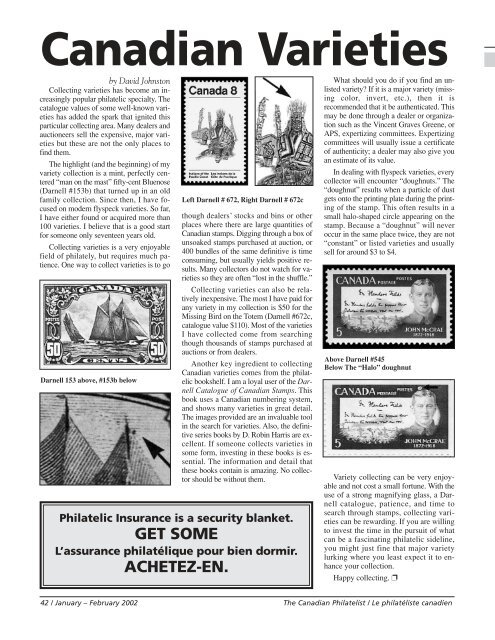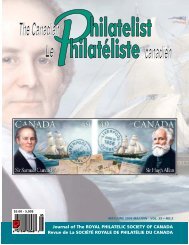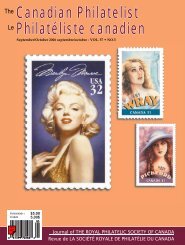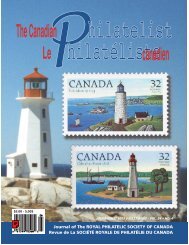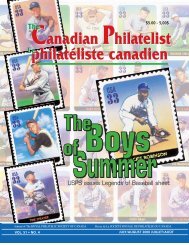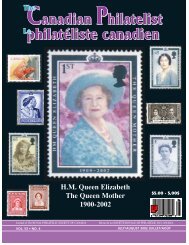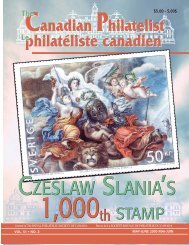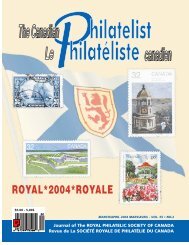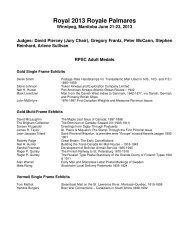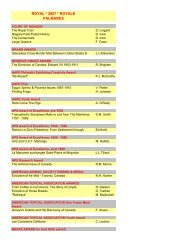Phil Pages Jan.Feb.2002 - The Royal Philatelic Society of Canada
Phil Pages Jan.Feb.2002 - The Royal Philatelic Society of Canada
Phil Pages Jan.Feb.2002 - The Royal Philatelic Society of Canada
Create successful ePaper yourself
Turn your PDF publications into a flip-book with our unique Google optimized e-Paper software.
Canadian Varieties<br />
by David Johnston<br />
Collecting varieties has become an increasingly<br />
popular philatelic specialty. <strong>The</strong><br />
catalogue values <strong>of</strong> some well-known varieties<br />
has added the spark that ignited this<br />
particular collecting area. Many dealers and<br />
auctioneers sell the expensive, major varieties<br />
but these are not the only places to<br />
find them.<br />
<strong>The</strong> highlight (and the beginning) <strong>of</strong> my<br />
variety collection is a mint, perfectly centered<br />
“man on the mast” fifty-cent Bluenose<br />
(Darnell #153b) that turned up in an old<br />
family collection. Since then, I have focused<br />
on modern flyspeck varieties. So far,<br />
I have either found or acquired more than<br />
100 varieties. I believe that is a good start<br />
for someone only seventeen years old.<br />
Collecting varieties is a very enjoyable<br />
field <strong>of</strong> philately, but requires much patience.<br />
One way to collect varieties is to go<br />
Darnell 153 above, #153b below<br />
Left Darnell # 672, Right Darnell # 672c<br />
though dealers’ stocks and bins or other<br />
places where there are large quantities <strong>of</strong><br />
Canadian stamps. Digging through a box <strong>of</strong><br />
unsoaked stamps purchased at auction, or<br />
400 bundles <strong>of</strong> the same definitive is time<br />
consuming, but usually yields positive results.<br />
Many collectors do not watch for varieties<br />
so they are <strong>of</strong>ten “lost in the shuffle.”<br />
Collecting varieties can also be relatively<br />
inexpensive. <strong>The</strong> most I have paid for<br />
any variety in my collection is $50 for the<br />
Missing Bird on the Totem (Darnell #672c,<br />
catalogue value $110). Most <strong>of</strong> the varieties<br />
I have collected come from searching<br />
though thousands <strong>of</strong> stamps purchased at<br />
auctions or from dealers.<br />
Another key ingredient to collecting<br />
Canadian varieties comes from the philatelic<br />
bookshelf. I am a loyal user <strong>of</strong> the Darnell<br />
Catalogue <strong>of</strong> Canadian Stamps. This<br />
book uses a Canadian numbering system,<br />
and shows many varieties in great detail.<br />
<strong>The</strong> images provided are an invaluable tool<br />
in the search for varieties. Also, the definitive<br />
series books by D. Robin Harris are excellent.<br />
If someone collects varieties in<br />
some form, investing in these books is essential.<br />
<strong>The</strong> information and detail that<br />
these books contain is amazing. No collector<br />
should be without them.<br />
<strong>Phil</strong>atelic Insurance is a security blanket.<br />
GET SOME<br />
L’assurance philatélique pour bien dormir.<br />
ACHETEZ-EN.<br />
What should you do if you find an unlisted<br />
variety? If it is a major variety (missing<br />
color, invert, etc.), then it is<br />
recommended that it be authenticated. This<br />
may be done through a dealer or organization<br />
such as the Vincent Graves Greene, or<br />
APS, expertizing committees. Expertizing<br />
committees will usually issue a certificate<br />
<strong>of</strong> authenticity; a dealer may also give you<br />
an estimate <strong>of</strong> its value.<br />
In dealing with flyspeck varieties, every<br />
collector will encounter “doughnuts.” <strong>The</strong><br />
“doughnut” results when a particle <strong>of</strong> dust<br />
gets onto the printing plate during the printing<br />
<strong>of</strong> the stamp. This <strong>of</strong>ten results in a<br />
small halo-shaped circle appearing on the<br />
stamp. Because a “doughnut” will never<br />
occur in the same place twice, they are not<br />
“constant” or listed varieties and usually<br />
sell for around $3 to $4.<br />
Above Darnell #545<br />
Below <strong>The</strong> “Halo” doughnut<br />
Variety collecting can be very enjoyable<br />
and not cost a small fortune. With the<br />
use <strong>of</strong> a strong magnifying glass, a Darnell<br />
catalogue, patience, and time to<br />
search through stamps, collecting varieties<br />
can be rewarding. If you are willing<br />
to invest the time in the pursuit <strong>of</strong> what<br />
can be a fascinating philatelic sideline,<br />
you might just fine that major variety<br />
lurking where you least expect it to enhance<br />
your collection.<br />
Happy collecting. ❐<br />
42 / <strong>Jan</strong>uary – February 2002 <strong>The</strong> Canadian <strong>Phil</strong>atelist / Le philatéliste canadien


